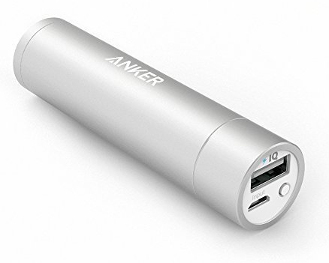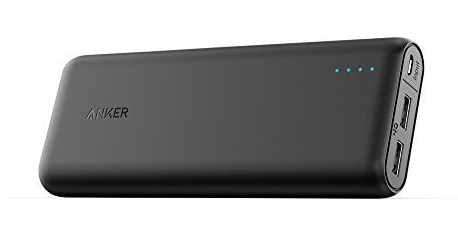Anker portable chargers
For a while now me and my wife have been using Anker’s line of portable chargers to charge our phones and tablets at times when we either don’t have easy access to mains power or we want to charge faster than the available chargers will allow. Their chargers have been very reliable and generally do very well in user reviews, especially given the large quantity of cheap but unreliable devices on the market. Portable chargers aren’t gaming hardware as such, so you might be wondering why I’m talking about them here. The answer is that we all have at least one USB-powered gaming device in our lives, even if it’s just a phone, and these chargers can be a big help in extending your play time.
We started off in late 2014 with an Astro Mini each, with a stated capacity of 3200mAh (3.2Ah). This seems to have since been renamed to (or replaced by) the PowerCore+ Mini with a slightly higher capacity. These are small devices, a bit larger than a tube of lipstick and you can easily throw one into your bag or purse, or even your pocket, without feeling like you’re carrying a weight around. They use Anker’s PowerIQ technology to identify your device and provide the highest supported charge current within the capabilities of the charger and the device. These days the age of the charger shows a bit in its maximum charge current of 1A though, which ends up being fairly slow for modern phones and tablets. However, if you’re in a tight spot and need a bit of juice to make an important call, or if you don’t mind waiting a little, then these are really handy to keep around. The build quality is good, with the aluminium casing feeling very solid and like it could take a few accidental drops without a problem.
In mid-2015 I added a PowerCore 16000 to my selection of Anker devices. This is a larger device with the much larger capacity of 16000Ah (16Ah) as indicated by the model name and a maximum output current of 4A split between the two ports, again using Anker’s PowerIQ technology. It’s possible to charge your phone or tablet multiple times given this much capacity (around 4-5 charges for my own phone) and this makes it really useful if you’re going to spend an extended time away from mains power. The device is, as you expect, larger and heavier, so it wouldn’t be something you could carry in your pocket and you might think twice about putting it in your purse, but it’s unnoticeable in a backpack. An additional feature compared to the Astro Mini, made possible by the larger size, is a set of four LEDs that indicate the charge level of the PowerCore’s internal battery pack. This is really useful to let you judge when you might need to start looking for a mains outlet. These are active when the PowerCore is being charged, when it is charging another device, or briefly when you press a button on the side of the PowerCore. As with the Astro Mini, the build quality is good. The PowerCore 16000 has a plastic rather than metal case, but it is solid with no give to it. As a bonus it’s a matt finish rather than a gloss one, so you won’t have a collection of fingerprints after using it for a day.
More recently my wife bought a PowerCore 20100 (the direct replacement for my PowerCore 16000). This has a higher capacity of 20100mAh (20.1Ah) but is otherwise largely the same design as the earlier model. Anker state that it can manage 7 charges of an iPhone 6S, 5 charges of a Galaxy S6, or 2 charges of an iPad Mini 4. Given our experience with it so far I’m inclined to agree with those numbers. In terms of design, there are only two changes of note for this model: i) the ports have been rearranged to give [output][output][input] instead of [output][input][output] and ii) the brightness of the charge level LEDs has been significantly reduced. This last change is a big bonus for me because the 16000 had the typical incredibly bright LEDs that you could light a room with. I have no idea why all consumer electronics went through a phase of using those, but I’m glad some companies are seeing sense at last.
Across the four devices we own we have so far experienced zero problems with them. As I mentioned previously, Anker portable chargers tend to get really good customer reviews and overall they appear to be a very high quality product retailing for a reasonable price. They are, of course, a little more expensive than the no-name devices, but the huge advantage in reliability and build quality is something I’m willing to pay for. As an example of how useful they can be, we recently had a 10 night vacation and managed to charge both our phones plus a tablet from our two PowerCore devices for the whole period. Only on the very last day did we resort to wall power to charge either the PowerCore devices or our phones.
Tags: Anker, Hardware


